If you’re looking for a houseplant that is laid-back yet glamorous then look no further. Easy to care for and incredibly beautiful, the Aglaonema Silver Bay is a great choice for houseplant beginners as well as experts who want a lovely but low-maintenance foliage plant.
Silver Bay Aglaonema has large, glossy leaves with a distinctive white-to-silver center surrounded by delicate patches of green. The Silver Bay is one of many varieties within the larger Aglaonema family, also known as Chinese Evergreen. It typically reaches a maximum size of 2 feet wide and 2 feet tall. Silver Bay requires infrequent watering and fertilizing and tolerates low or artificial lighting, making it a popular houseplant.
Let’s dig into where the silver bay plant comes from and what it needs to thrive in your home!
RELATED: Can’t get enough variegated plants? Stop by our post on Scindapsus Pictus to see another silvery option. Or learn how to care for Pothos N Joy to see another fun pattern beauty!
Table of Contents
Aglaonema Silver Bay Background
Aglaonema is a class of tropical plants that grow in the wild on the Pacific island of New Guinea and in the tropical parts of Asia. This native habitat is where Aglaonema gets its common name of Chinese evergreen.
There are a large number of Aglaonema cultivars, but they all share certain core features:
- Large, pointed, glossy leaves that usually feature variegation
- Short stems
- On older plants, a spring or summer bloom
They grow about 24 inches tall and wide, which is ideal for indoor spaces. Generally Aglaonema ‘Silver Bay’ will grow to be wider than it is tall.
The Silver Bay gets its name from the silvery coloring in the center of the large leaves. This center swath is bordered by patchy green, with shades of gray, light green and dark green forming subtle stripes.

There is a Silver Bay lookalike plant to be aware of: The Dieffenbachia, also known as dumb cane. This is actually a completely different species than Aglaonema, but they look very much alike.
Here’s a photo of a Dieffenbachia leaf that shows the nearly-identical variegation pattern:
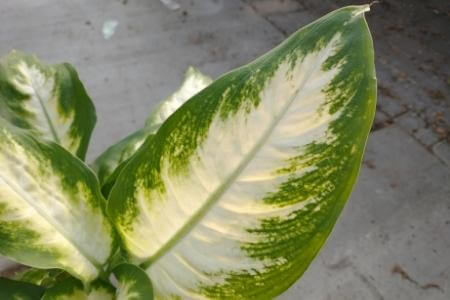
I once spotted a Dieffenbachia at the greenhouse, and I didn’t realize it wasn’t a Silver Bay until I was holding it. That’s how similar these two plants look!
One of the key differences is that Dieffenbachia has a whiter color to the leaf center and Silver Bay is more gray/silver. But if you happen to pick up a Dieffenbachia by mistake, don’t worry too much- it’s still a fantastic houseplant that thrives in many of the same conditions as Silver Bay. Then just make sure you get a Silver Bay on the next try!
Aglaonema will sometimes flower indoors, producing a white or green spathe surrounding a yellow spadix. The Aglaonema flower somewhat resembles that of a peace lily:

Usually, only mature plants will produce a flower. Some varieties have flowers that produce so much pollen it’s more convenient to cut them off before they bloom. After flowering, some Aglaomena varieties develop a red, inedible berry.
Silver Bay Aglaonema is pretty tolerant of low-light conditions, thanks to its status as an understory plant in tropical forests. According to the University of Florida IFAS Extension, gardeners in China and other parts of Asia grew and gifted these plants as symbols of good fortune long before their introduction to the Western world in 1885.
In 1989, NASA included Aglaonema in its Clean Air Study. Their goal was to figure out which plants were best at filtering toxins from the sealed air inside a space-faring capsule. According to this study, Aglaonema is highly effective at scrubbing benzene and formaldehyde from the air.
That’s good news for us earthlings too, since both of these chemicals are common household pollutants.
Aglaonema Silver Bay Care
If this is your first houseplant, you’re in luck: Chinese Evergreen Silver Bay isn’t too picky about their environment once you’ve got a few basics covered:
- An appropriate pot
- Good potting soil
- Lighting conditions
- Watering routine
- Room temperature
- Humidity levels
- Fertilizing
- Routine pruning
- Leaf cleaning
- Seasonal dormancy patterns
In this section, we’ll get into the details of each care need so you can keep your plant happy and healthy for the long term.
Choose the Correct Pot Type and Size
The silver bay plant will do well in almost any type of pot:
- Terra cotta
- Ceramic
- Plastic
- Cement
- Fiberglass
- Wood
While any of these materials will work just fine, I must admit a preference for classic terra cotta or other clay pots because their porous surface lets air in and water out.
As far as how big the pot should be, you don’t want to go overly large. Silver Bay is a relatively slow grower, and a too-large pot holds extra soil that holds extra moisture. And that could lead to water-logged soil, potentially damaging your plant’s root system.
So choose a pot that’s a maximum of a few inches larger than your plant’s root ball.
You can also measure the plant’s height from the soil line to the top of its tallest leaf. Divide that number by 3, and the result, in inches, is a good estimate of the ideal pot diameter. Round up to the next largest pot size if you don’t end up with a whole number after dividing.
Here’s a visual that gives you some examples:
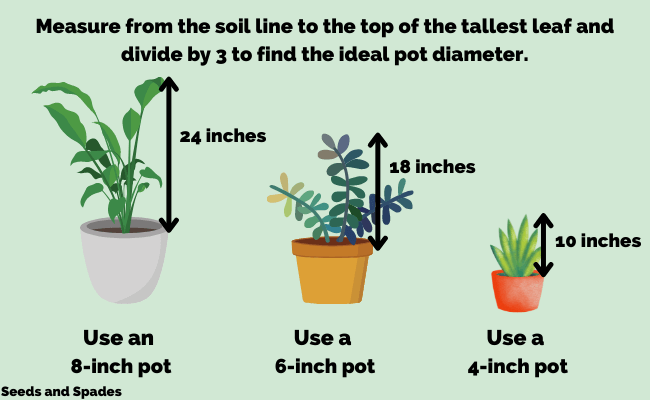
Use a Good Potting Soil
Any good-quality potting soil will work for this houseplant. But make sure to never use products labeled “topsoil” or “garden soil.” These are dense soils that will compact quickly in any kind of container. They’re not meant for houseplants, so save them for your outdoor vegetable garden!
My favorite potting soil is Gardener’s Gold from Bumper Crop. Here’s what it looks like:
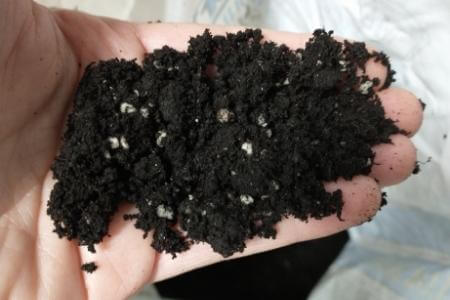
This soil’s base is compost for added nutrition, and it’s already got perlite for enhanced drainage. You can get a 1 cubic-foot bag on Amazon, but it might be cheaper to get a smaller bag from your local greenhouse, so I’d recommend checking there first.
If the potting soil you choose doesn’t have perlite already blended in, you can add your own or mix in some orchid bark. I’ve used the Perfect Plants brand of perlite before with good results.
Lighting Needs
Your Silver Bay can thrive in a variety of light conditions, so it’s great for those odd areas around your house that don’t get a lot of sun.
It will grow fastest and look best in bright but indirect sunlight, but it can also tolerate low light such as a north-facing window or fluorescent office lighting.
RELATED: Aglaonema is just one suggestion for plants that grow well away from direct sunlight. Stop by our post on plants that thrive in windowless spaces to see 18 more options!
Watering Frequency
Chinese evergreen plants are not heavy drinkers, and you’re better off watering a bit too little than the alternative. Even if you forget to water for a few extra days from time to time, this easy-going plant is very forgiving and won’t show any ill effects.
Allow the first 2 inches of soil to dry out between watering. You can test this by sticking your finger into the soil. When the soil feels dry up to about your second knuckle, your plant is ready for a drink.
Ambient Temperature
The one thing you’ll have to watch a little more carefully is temperature: Aglaonemas need things warm.
Don’t let the air get colder than 59 degrees Fahrenheit in the room where you keep your plant. Remember, this is a tropical plant, so try to maintain temperatures in the 60s and 70s.
If you live in an area that experiences cold winters, move your plant to a warm interior room far away from any drafty or chilly windows. And in summer, situate your Silver Bay away from air conditioning registers, or use an air-deflecting vent cover.
Humidity
While your Silver Bay will tolerate the average home’s humidity levels just fine, providing a little extra humidity will help your plant look its absolute best.
Plant humidifiers are the most reliable way to give your plant a humidity boost, and there are many good options out there for a reasonable price. We’ve covered some outstanding options in our post where we cover our favorite plant humidifiers.
If you don’t want to go the humidifier route, you can also keep humidity levels up in a few different ways:
- Keep your Silver Bay in the kitchen or bathroom, which usually have higher humidity than other rooms.
- Group it with other houseplants. As their leaves transpire the moisture from their roots through their leaves, they can create their own little pocket of humidity.
- Place a bowl or jar of water right next to your plant so they can absorb any passing water vapor.
- Keep the plant on a tray lined with pebbles and filled halfway with water. Change the water regularly to keep gnats away. For step-by-step instructions, stop by our post on building a pebble humidity tray.
- Mist the leaves regularly with a plant mister or spray bottle full of water.
Fertilize Sparingly
Your Silver Bay plant is not a heavy feeder, meaning that it doesn’t need a lot of fertilizer or supplemental nutrition. If you give too much fertilizer, you risk giving your plant’s roots a chemical burn.
During spring and summer, feed it using a water-soluble fertilizer about every six weeks, and don’t give any during the winter. The liquid formula from Espoma is a good choice.
Routine Pruning
Once your Silver Bay plant is a couple years old, you may want to do some selective pruning in spring. Use sanitized scissors or shears to snip off a handful of the largest, oldest leaves. This will allow more light to reach the rest of the leaves and usually triggers a flush of new growth.
Leaf Cleaning
Like other houseplants with large, glossy leaves, Aglaonema gets dusty. So clean the leaves regularly with a damp cloth to remove dust and keep the plant healthy.
Dust-free leaves make it easier for the plant to photosynthesize and transpire oxygen, and the water will also help the cells stay hydrated.
Dormancy
Although this is a Chinese Evergreen that never drops all its leaves, the Silver Bay plant still undergoes dormancy every winter.
During this time, it won’t produce any new leaves and won’t grow much, so it doesn’t need to be fertilized. Take extra care not to overwater your Aglaenema in the winter, as cooler temps keep the soil in your pot moist for longer.
Aglaonema Varieties Similar to Silver Bay
Depending on which botanical registry you consult, the total number of Aglaonema species is anywhere from 12 to 24. To make things little more confusing, there are seemingly endless varieties, or cultivars, within the each species. The variegation can be reddish, pinkish, or silvery; some types have more oval leaves while others are more narrow.
We can’t cover all the Aglaonema varieties out there, but here are some of the most popular ones that look similar to the Silver Bay:
Aglaonema “Silver Queen.” Silver Queen is one of the most common Aglaonemas, and it has silvery-green variegation on long, narrow leaves in a sharply angled, chevron-like pattern. It is lovely enough to earn the Royal Horticultural Society’s Award of Garden Merit.

Aglaonema “Diamond Bay.” This variety has leaves that reach up to a foot long, with wide margins of deep green and a broad silver stripe down the center with wavering irregular edges.
Diamond Bay arises from a genetic mutation of a Silver Bay and has now been developed as its own stable cultivar. The main difference is that Diamond Bay has broader green borders compared to a Silver Bay.
Here’s a Diamond Bay I saw at one of my local greenhouses. I had my 4-year-old son with me, and the plant was almost as tall as him!

Aglaonema “Stripes.” The greenhouse also had this lovely Aglaonema Stripes. With creamy white bands against a bright-green background, you can see where it gets its name pretty easily!

Aglaonema “Emerald Bay.” This is actually one of the parent types of Aglaonema Silver Bay. It has similarly large leaves with a broad stripe of gray-green variegation, though it isn’t as silvery as Silver Bay.

Aglaonema “Moonlight Bay.” Moonlight Bay has long, broad leaves that have an almost painterly look. Bands of silver, silver-green and green run from the center vein to the leaf edges, along with the occasional splash of cream.
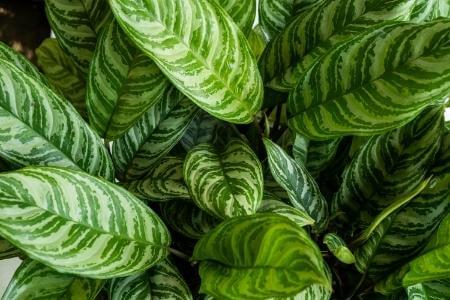
Where to Buy Aglaonema Silver Bay
Unlike some Instagram-famous houseplants that are extremely difficult to track down (and expensive to boot!), Aglaonema Silver Bay is actually quite accessible and affordable.
I see Aglaonema plants of one kind or another at my local greenhouses all the time. They’re all beautiful and I wouldn’t mind having each and every one in my own collection.
But houseplant shipments are very hit-or-miss, and even the greenhouse likely doesn’t know exactly what their next live goods order will contain. So if you want to get your hands specifically on a Silver Bay now, ordering from the internet is your best option.
Etsy is my favorite source for ordering live plants. You can communicate directly with the seller and ask questions if needed. Also, these are small businesses that have a vested interest in keeping their customers happy.
One awesome source to check out is Bijan Tropicals. They are very responsive to inquiries and produce gorgeous plants. I highly recommend them!
These other sellers also had lovely Silver Bay plants in stock at the time this post was published:
Repotting Aglaonema Silver Bay
All Aglaonemas are fairly slow-growing plants, and Silver Bay is no exception, especially if you have it in dimmer light. Because of this, you likely won’t have to repot your Silver Bay more than every couple of years.
Be on the lookout for these signs that your Silver Bay is ready to move to a larger home:
- Plant produces very little new growth in spring and summer
- Roots begin poking out of the drainage holes or over the soil surface
- Plant is always thirsty for water despite regular waterings
- White salt deposits are forming on the surface of the soil
- You’ve had it for 2+ years without repotting
Here’s how to repot your plant successfully:
Step 1: Lay a large sheet of brown paper or another protective covering over your work surface to make clean-up a little easier.
Step 2: Gently remove your plant from its current pot and brush away as much old soil as possible.
Step 3: Take a close look at the roots; they should appear white-to-tan and feel firm. If you see any sections that are brown or soft, trim them away with a pair of clean scissors or pruning shears.
Step 4: Carefully work any compacted root sections apart to help stimulate new growth. If you see any overgrown roots, trim them down by a couple of inches.
Step 5: Add some fresh soil to your new pot, and settle your Silver Bay in. Fill in around the sides of the root ball with soil, and gently tamp the soil down.
Don’t water for a few days after repotting. This gives any trimmed roots the chance to heal a bit before getting wet and also encourages the roots to spread out in search of moisture.
RELATED: We’ve put together a detailed photo tutorial of the repotting process that walks you through each step listed above. We used a pothos plant for our model in the post, but the same process applies to Aglaonema as well. Stop by to get more details!
Potential Problems with Aglaonema Silver Bay
Luckily, a Silver Bay Chinese evergreen is largely free of common houseplant problems. But issues may crop up occasionally. Here’s what to do if they do:
Brown Leaf Tips
This is the most common problem with an Aglaonema: crunchy brown leaf tips on an otherwise healthy plant. This can happen for a few reasons:
- A hydration/humidity problem. Re-hydrate your plant by letting it soak in a bowl of cool water for several hours. Then take a look at your watering routine to make sure that you’re watering often enough, and mist the plant once a week or more with a plant mister.
- Chlorine, fluoride, and salts in tap water. Use a good water filter to protect your plants (and you!) from the build-up of these components in cell tissue.
- Chemical damage if you’ve over-fertilized. If you’ve given fertilizer more often than every 6 weeks, flush the soil well to wash away any retained fertilizer. Thoroughly drench the soil 4-5 times, letting the water run freely through the drainage holes. After that, set your plant in indirect light to recover for a few days.
Leaf Discoloration or Wilting
An over-watered Aglaonema will develop yellow, mushy, and limp leaves. Cut off the discolored leaves and allow the plant to dry out quite a bit before watering again, and make sure not to water it as frequently going forward.
Under-watering, conversely, will result in wilted leaves, and a serious case will create brown tips or leaves. Rehydrate as outlined above if necessary, and adjust your watering schedule to be slightly more frequent.
A good rule of thumb is to water about once a week, and use your finger to poke the soil and test it for dryness or dampness beforehand. Remember, you’re looking for the top 2 inches of soil to feel dry; that’s when it’s time to water.
Aglaonema Pests
This plant is not all that vulnerable to pest attacks, but it could still happen.
Keep an eye out for mealybugs or scale insects on the stems.


Use a cotton ball or swab dipped in rubbing alcohol to remove them. Spray your plant down with insecticidal soap to kill the remaining bugs.
Aphids are small soft-bodied green insects that produce a sticky, shiny substance called honeydew.
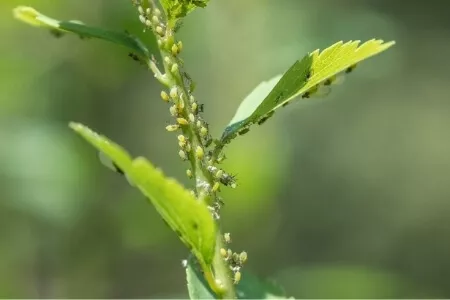
Remove them by rinsing the leaves of the plant in a strong stream of water in the shower or with a hose. Insecticidal soap is effective for aphids too, so spray your plant generously.
For any pests, you may need to repeat your insecticidal soap application a few times to eradicate the pests.
Propagating Aglaonema Silver Bay: 2 Methods
It’s best to propagate an Aglaonema Silver Bay in springtime as it enters the growing season. You can propagate this plant using two methods:
- By root division
- By stem cuttings
Note: When working with an Aglaonema plant, always wear gloves, as its sap contains compounds that can irritate the skin.
Method 1: Propagate Aglaonema By Root Division
Aglaonema naturally spreads through an underground rhizome, which is something like an overgrown root. As the main plant grows, it sends out offshoots from the rhizome, and you can separate this new growth into independent plants.
Here’s how:
Step 1: Identify points of new growth. This photo shows a single plant with multiple points of growth that you could separate. I’ve marked three with arrows:

Step 2. Tap the pot on all sides to loosen the root ball. If you need to, run a knife around the inside of the pot to separate it from the soil. Tilt the pot onto its side and gently slide/wiggle the root ball out.
Step 3. Brush away some of the dirt. Use your hands to gently tease out a section of the roots.
Step 4. Once you have a bundle of roots that is clearly connected to a portion of the plant, use your hands to gently separate it from the mother plant. Some people use a small trowel or other tool for this step, and you can if you want to. But separating plants by hand gives you more control over the pressure you apply to your plant.
Step 5. Add a couple of inches of potting soil to your new pot(s), and settle each divided section into its new home. Fill in the rest of the pot with soil, and set your newly-divided plants in bright, indirect sunlight. Keep the soil moist for the first week until they get over the shock.
Method 2: Propagate Aglaonema From Cuttings
This method is slightly less reliable than propagating through root division, and you’ll have to wait longer to have an established plant since you’re starting from a single leaf.
But it’s definitely easy, and you can make use of leaves you cut during routine pruning!
Step 1. Use sanitized scissors or knife to remove a stem that is at least 5 inches long. Make your cut close to the base of the plant. This photo shows a couple of good places to cut:

Step 2. This step is optional, but dipping the cut end in powdered root hormone can help it to root out.
Step 3. Place the cut stem into a jar or glass of clean water.
Step 4. Replace the water every week, and in 2 to 3 weeks, the cutting will send out roots.
Step 5. Once the cutting has a few inches of roots, pot it up into a small container and place in a warm, bright spot. The new plant is used to having very moist roots, so water it lightly every day for seven days, then every other day for another week, and finally once a week or less going forward.
Frequently Asked Questions about Aglaonema Silver Bay
Key Takeaways
- Aglaonema Silver Bay has beautifully variegated leaves in shades of silver, green and gray. The centers of the leaves are silvery-white and the borders feature patches of green.
- Silver Bay Chinese Evergreen is a low-maintenance houseplant that’s perfect for beginners. It requires moderate watering and infrequent fertilizing, and it tolerates a variety of lighting conditions, including low light, artificial lighting or bright indirect light.
- Silver Bay Aglaonema has few pests or other problems.
- You can propagate Aglaonema Silver Bay by root division or stem cuttings. Root division has the best success rate.
Final Thoughts
In a sea of competition, Aglaonema Silver Bay absolutely stands out with its beautiful color and easy care. It can bring light and leaves into some of the darkest indoor corners, and it’s also a great plant for cleaning indoor air in style.
Have you ever had one of these beauties? Let us know in the comments!

